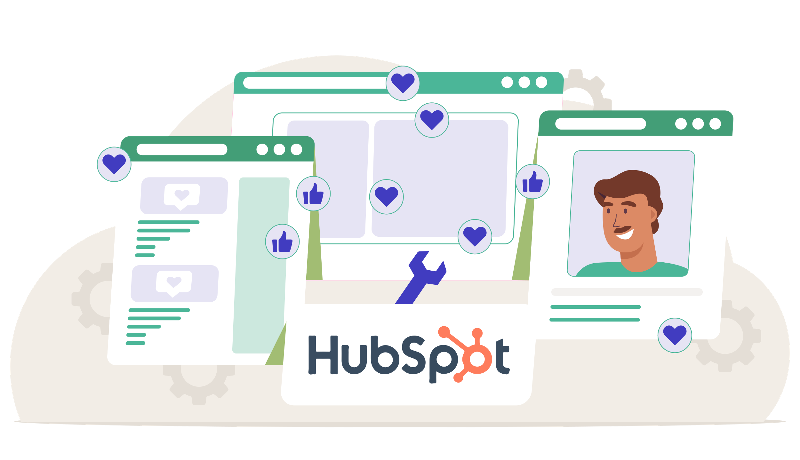Rivoluziona il tuo social media marketing con HubSpot. Automatizza i post su più canali e usa l'AI per massimizzare il tuo coinvolgimento.
Migliora subito le performance di Twitter: 21 semplici consigli
Se gestite un'azienda o state pensando di lanciarne una, saprete sicuramente che la creazione di un seguito sui social media può aiutare il vostro marchio a crescere. La presenza sui social media può anche aiutare a stabilire la vostra autorità nella vostra nicchia. Ecco alcune idee, suggerimenti e pratiche rapide per aiutarvi a stabilire meglio la presenza della vostra azienda su Twitter e ad attirare più follower sui social media.
.

1. Maniglia di Twitter.
Rendetelo il più simile possibile al nome della vostra azienda. Aggiungetelo al vostro sito web, alle firme delle e-mail, alla fiancata del vostro veicolo per le consegne e in qualsiasi altro posto in cui sia possibile metterlo in mostra. Rendetelo memorabile.
2. Biografia su Twitter.
Assicuratevi di utilizzare l'intero limite di caratteri; attualmente la bio è limitata a 160 caratteri. Assicuratevi che la vostra offerta chiave sia visibile nella prima riga. Utilizzate hashtag relativi al settore che vi aiutino a comparire nei risultati di ricerca. Fornite un URL abbreviato e compilate i link alla posizione e al sito web sotto la biografia.
3. Logo e immagine di copertina.
Non lasciate l'immagine vuota. Utilizzate un logo ottimizzato per adattarlo allo spazio disponibile. Aggiungete un colore coerente con il marchio al vostro profilo per farlo risaltare. (Per saperne di più su come essere coerenti nel branding dei social media).
4. Promuovete gli altri.
Creerete un rapporto di fiducia se sarete visti e ascoltati nei tweet degli altri. Siate sinceri e onesti e includete le vostre riflessioni; non limitatevi a fare un taglia e incolla. Pubblicate un link e un breve commento, citando l'autore per nome.
5. Retweet e risposte.
Ritwittate i contenuti pertinenti e rispondete ai tweet pertinenti per mantenere una presenza solida. Se qualcuno condivide un feedback positivo, ritwittatelo con un messaggio di ringraziamento. Se trovate un articolo o qualcuno ha lanciato una minaccia di messaggi in linea con il vostro marchio, mostrategli un po' di affetto. Questi sono tutti esempi di contenuti d'impatto da ritwittare. Ricordate che i vostri retweet riflettono il vostro marchio e devono essere in linea con il vostro scopo e i vostri valori.
6. Siate coerenti nel creare fiducia.
Questo vale per tutto, dallo stile dei vostri tweet all'ora e alla frequenza con cui li twittate, fino al contenuto vero e proprio. Create un calendario dei contenuti per i social media e mantenete una cadenza regolare. Se twitterete costantemente informazioni interessanti e utili senza essere particolarmente autopromozionali, creerete fiducia per voi e per il vostro marchio.
7. Concentratevi sulla vostra nicchia.
Iniziate a twittare su argomenti strettamente correlati al focus dei vostri prodotti. In questo modo diventerete una voce esperta nel vostro campo e la credibilità renderà più probabile che i vostri follower inizino a usare il vostro prodotto. Avete dimostrato di essere disposti a fornire valore in anticipo.
8. Siate creativi.
Non concentratevi solo su argomenti banali e sui soliti formati di tweet. Fate qualcosa di originale, almeno qualche volta. Considerate il vostro account Twitter per quello che è stato pensato, un micro-blog. Pensate attentamente alla formulazione dei vostri tweet.
9. Siate reattivi.
Trasformate l'account Twitter della vostra azienda in un canale di assistenza clienti. Rispondete alle critiche, alle domande e ai commenti. Rispondere rapidamente rafforzerà la vostra immagine di marchio che si preoccupa dei clienti ed è desideroso di coinvolgerli e aiutarli.
10. Appuntate un tweet.
Appuntate un tweet accattivante in cima al vostro profilo. Potreste appuntare un video dimostrativo di un prodotto, un link a un articolo pubblicato, una storia in evidenza o semplicemente una foto di un team felice. Cambiate regolarmente per mantenere il vostro pubblico coinvolto.
11. Stabilite una frequenza.
Potreste non avere una persona dedicata ai social media. Stabilite una strategia mensile con il team che prenda in considerazione tutte le date chiave, i lanci dei prodotti, le offerte speciali o le vendite a tempo limitato. Una volta stabilito il piano, inserite i tweet in un programma che potete automatizzare con uno dei tanti strumenti disponibili.
12. Creare grandi contenuti.
Potete parlare dell'ultima funzionalità aggiunta, del lancio del sito web, di frammenti di feedback dei clienti, di tweet in diretta da eventi, di like e retweet di contenuti rilevanti per il vostro marchio. Assicuratevi di mescolare contenuti originali e retweet con l'aggiunta del vostro commento.
13. Determinate i momenti migliori.
Utilizzate le analisi e gli esperimenti per trovare il momento della giornata che produce il maggior numero di impressioni, like e retweet.
14. Incorporare gli hashtag.
È necessaria una strategia per utilizzare gli hashtag migliori per i vostri tweet. Utilizzate parole chiave pertinenti al vostro marchio. La pratica migliore è non più di due hashtag per tweet. Create un hashtag unico se partecipate a un evento o lanciate un prodotto. Assicuratevi che il team sappia incorporare questi hashtag quando twitta. Per aumentare la visibilità, mettete le maiuscole in ogni parola; non più di 2 o 3 parole.
15. Alcune idee per i tweet:
- Immagini dei membri del team al lavoro.
- Teaser per i prossimi rilasci o aggiornamenti.
- Ringraziare un datore di lavoro o un cliente, augurargli buon compleanno o buon anniversario della sua prima visita al vostro sito web.
- Festeggiate una pietra miliare della vostra azienda o del vostro account Twitter offrendo uno sconto speciale.
- Twittare un gioco di parole. Un bonus se incorpora un riferimento al vostro marchio.
- Condividete contenuti relativi alla vostra attività. Ad esempio, se siete un ristorante, suggerite attività divertenti vicino alla vostra sede.
- Rispondete a qualcuno che ha parlato del vostro marchio, sia in modo positivo che negativo.
Potrebbe Piacerti Anche Questo Post:
16. Siate concisi.
Ogni tweet deve concentrarsi su un messaggio specifico. Includete un link per trasmettere un messaggio più lungo su un post del blog o sul vostro sito web.
Aggiungete personalità e aumentate il tasso di coinvolgimento includendo un'immagine, una GIF o un video. È possibile allegare fino a quattro foto a un singolo tweet.
18. Fate domande.
Questo è un modo efficace per interagire con il pubblico, coinvolgere i lettori nelle conversazioni e capire le opinioni delle persone. Twitta una domanda aperta o usa Twitter Polls per fare un sondaggio.
19. Dedicate tempo all'ascolto.
Volete sapere cosa le persone dicono e condividono su Twitter, sia che stiate monitorando per mitigare i rischi maggiori sia che stiate controllando il sentiment generale sul vostro marchio. Imparate dalle storie di cautela delle aziende che non hanno adottato il social listening e si sono ritrovate con un vero e proprio disastro di PR. Mettete in atto un piano per le comunicazioni di crisi e sperate di non doverlo mai usare.
20. Usate le analisi.
Twitter Analytics vi mostra quali contenuti funzionano per voi e per il vostro pubblico. La parte migliore? È gratuito! Potete monitorare i tassi di coinvolgimento nella Tweet Activity Dashboard. Utilizzate questi dati per capire che tipo di informazioni il vostro pubblico vuole vedere da voi. Sperimentate spesso nuovi elementi e continuate a perfezionare ciò che funziona bene.
21. Tattiche avanzate.
Dopo aver imparato a usare Twitter per la vostra attività, provate a fare qualcosa di più. Le idee includono la pubblicità su Twitter, ospitare una chat su Twitter e trasmettere video in diretta.
Conclusioni:
Come già detto più volte, la coerenza è fondamentale su tutte le piattaforme di social media. Assicuratevi che il vostro marchio sia coerente con la nostra lista di controllo GRATUITA per il branding sui social media. Fate clic qui sotto per ottenere la vostra:
Questo contenuto è disponibile in:
- Tedesco: Twitter-Leistung sofort verbessern: 21 einfache Tipps
- Inglese: 21 Simple Ways to Immediately Improve Twitter Performance
- Spagnolo: Mejora ya tu rendimiento en Twitter: 21 trucos sencillos
- Francese: 21façons simples d'améliorer immédiatement les performances de Twitter
- Rumeno: 21 de modalități rapide de a îmbunătăți performanța pe Twitter
- Cinese: 立即提高 Twitter 性能的 21 个简单方法










Facci sapere cosa ne pensi.